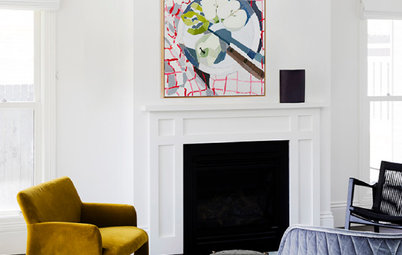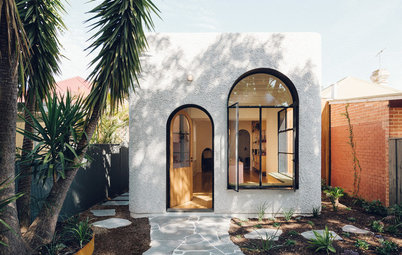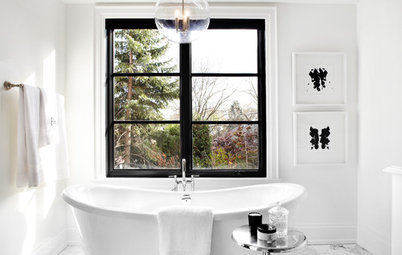Decorating
Popular Houzz Series
Popular Houzz Series
Appears in
See also
Fun HouzzFrom The ProsHouzz Around The WorldProject Of The WeekStickybeak Of The WeekQuizzesCreatives At HomeAt Home With...Best Of The WeekRoom Of The WeekDesigner Profiles3 Things I Wish My Clients KnewHow Do I...Buyer's GuidesExpert EyeInnovation AlertSo Your Style Is...Spotted!Picture PerfectBefore & AfterBudget BreakdownHome TimeMade Local
How Do I... Choose the Right Picture Frames?
Make your artwork and photos shine with fabulous frames – here are the on-trend styles you need to know about
In this practical series, we ask experts to answer your burning home and design questions. Here, Stephanie Waterman and Karen Bell, interior stylists and design authorities behind The Stylephiles, reveal how to frame art for maximum impact.
Framing can be expensive, so the smart choice is to pick something clean and timeless. Working with the proportions of the artwork is important too; the frame should enhance the artwork without being distracting or so large that it swallows up the main event.
Find an interior decorator on Houzz near you to help you choose the perfect frames for your art
Find an interior decorator on Houzz near you to help you choose the perfect frames for your art
What are the most important things to consider when choosing a picture frame?
1. Proportion: This is a key consideration when selecting the right picture frame. The mat board and outer moulding should always enhance the art and draw the viewer’s eye towards it – so be sure not to either dwarf or drown your artwork with a mat board that is too small or large.
Our general rule of thumb would be to start with a border from 50 millimetres for an A3-size frame. But experiment with what works for the individual artwork; you may find that a smaller artwork can shine with a substantial surrounding border and frame.
1. Proportion: This is a key consideration when selecting the right picture frame. The mat board and outer moulding should always enhance the art and draw the viewer’s eye towards it – so be sure not to either dwarf or drown your artwork with a mat board that is too small or large.
Our general rule of thumb would be to start with a border from 50 millimetres for an A3-size frame. But experiment with what works for the individual artwork; you may find that a smaller artwork can shine with a substantial surrounding border and frame.
2. Colour and finish: This can trip up even the most stylish homeowner. When choosing a frame’s colour and finish, take into consideration the colours and finishes in the surrounding area, as well as how much natural light it receives.
If you’re choosing something for a bedroom, go for a darker frame, a slim timber one or even something vintage. For a contemporary, open-plan living area, keep frames clean and modern.
Picture Perfect: 31 Artwork Arrangements to Imitate
If you’re choosing something for a bedroom, go for a darker frame, a slim timber one or even something vintage. For a contemporary, open-plan living area, keep frames clean and modern.
Picture Perfect: 31 Artwork Arrangements to Imitate
3. Decor: Although a frame’s main task is to emphasise your artwork, you should also consider where the art will be hung as it should feel complementary to its surrounds.
Think about what else shares the wall and the surrounding space. If you have a heavy black iron sideboard beneath your artwork, for example, balance it out with a lighter frame in white or oak. Too much of one material in any space will work against the overall goal of creating a cohesive, balanced space.
9 Everyday Items You’d Never Think to Frame
Think about what else shares the wall and the surrounding space. If you have a heavy black iron sideboard beneath your artwork, for example, balance it out with a lighter frame in white or oak. Too much of one material in any space will work against the overall goal of creating a cohesive, balanced space.
9 Everyday Items You’d Never Think to Frame
Image by Samsung The Frame
What are some arrangement looks you’re loving?
For those blessed with a large space, we love a single, oversize artwork hung above the hero piece in the room, such as the bed, sofa or dining table.
Gallery walls and artwork clusters have been trending for a while now, but it’s an approach to hanging art we are delighted to see continue. We love a mix of small and large, high and low frames creating an eclectic yet personal style.
You can even incorporate the latest smart appliances into your artwork arrangements. The Samsung Frame TV – which is part-time television and part-time art – can be hung on its own above a sideboard or clustered within a wall arrangement.
What are some arrangement looks you’re loving?
For those blessed with a large space, we love a single, oversize artwork hung above the hero piece in the room, such as the bed, sofa or dining table.
Gallery walls and artwork clusters have been trending for a while now, but it’s an approach to hanging art we are delighted to see continue. We love a mix of small and large, high and low frames creating an eclectic yet personal style.
You can even incorporate the latest smart appliances into your artwork arrangements. The Samsung Frame TV – which is part-time television and part-time art – can be hung on its own above a sideboard or clustered within a wall arrangement.
How do I know which frame will suit my artwork?
As a guide, pair these frames and art:
As a guide, pair these frames and art:
- Dark or metallic frames for more sophisticated art or anything vintage or historical.
- Blonde timber or white frames for modern art, photographic art, line drawings or Scandinavian prints.
- Heavy box frames for original canvas works that need the messy canvas edges covered. This will make the piece feel finished and complete.
- Ornate frames to enhance a beautifully detailed artwork or to complement boho or eclectic decor.
Could you share a couple of frame styling tips?
- In small spaces with white walls, white frames visually disappear into the surrounding walls, minimising any visual clutter. This will keep your space feeling light and open.
- A single, oversize piece in a small room can actually add scale – as long as you don’t over-clutter the other walls with art. Pick one amazing piece, let that be the hero, and allow the palette and style of that focal piece inform the rest of the room’s decor choices.
- Highlight a hero artwork in a room with a wall light. The light it casts will also add visual texture and interest to your walls.
Image by Samsung The Frame
Your turn
What’s your favourite tip for arranging art? Tell us in the Comments below, like this story, save your favourite images and join the conversation.
More
Want more decorating insight? Don’t miss Best of the Week: 40 Cosy Rooms Done Right
Your turn
What’s your favourite tip for arranging art? Tell us in the Comments below, like this story, save your favourite images and join the conversation.
More
Want more decorating insight? Don’t miss Best of the Week: 40 Cosy Rooms Done Right



















Clean, pared-back frames – think oak and walnut for heavier artwork and classic white for anything that needs glass.
For oils and works on canvas, a timber box frame in light oak or rich walnut would be our preference. The slim facing profile doesn’t detract from the art and adds warmth and texture to the room scheme.
For artworks on paper, prints and photographic works, we are big fans of simple white frames – they’re great for making the artwork the focal point.